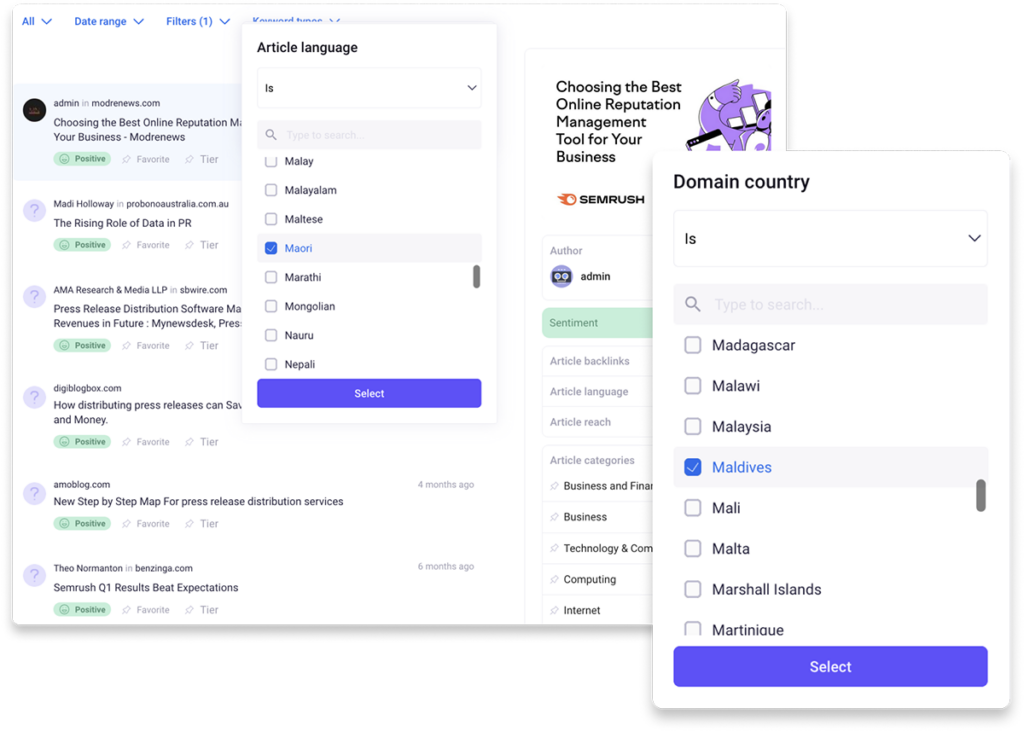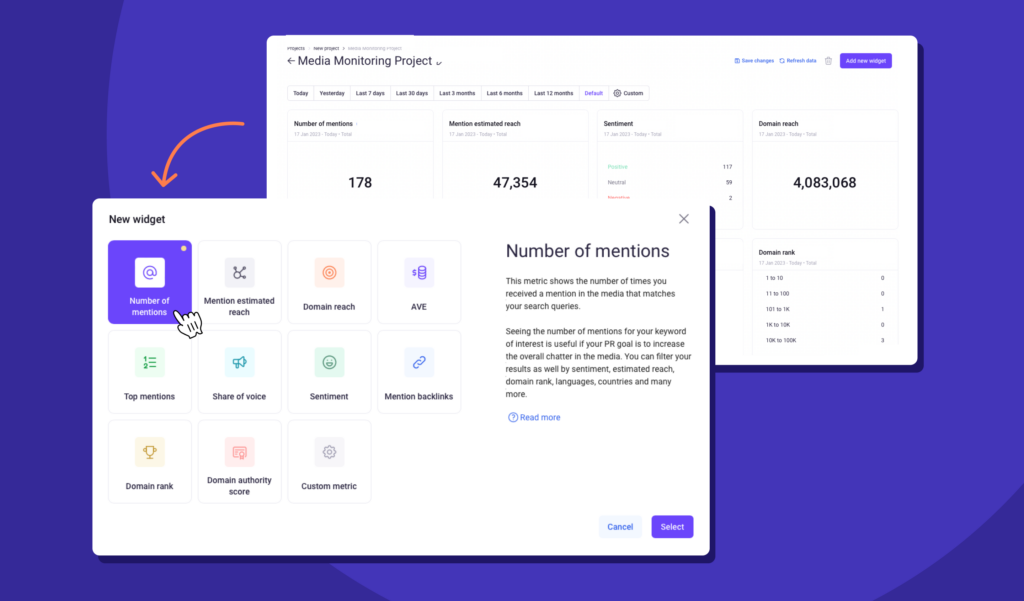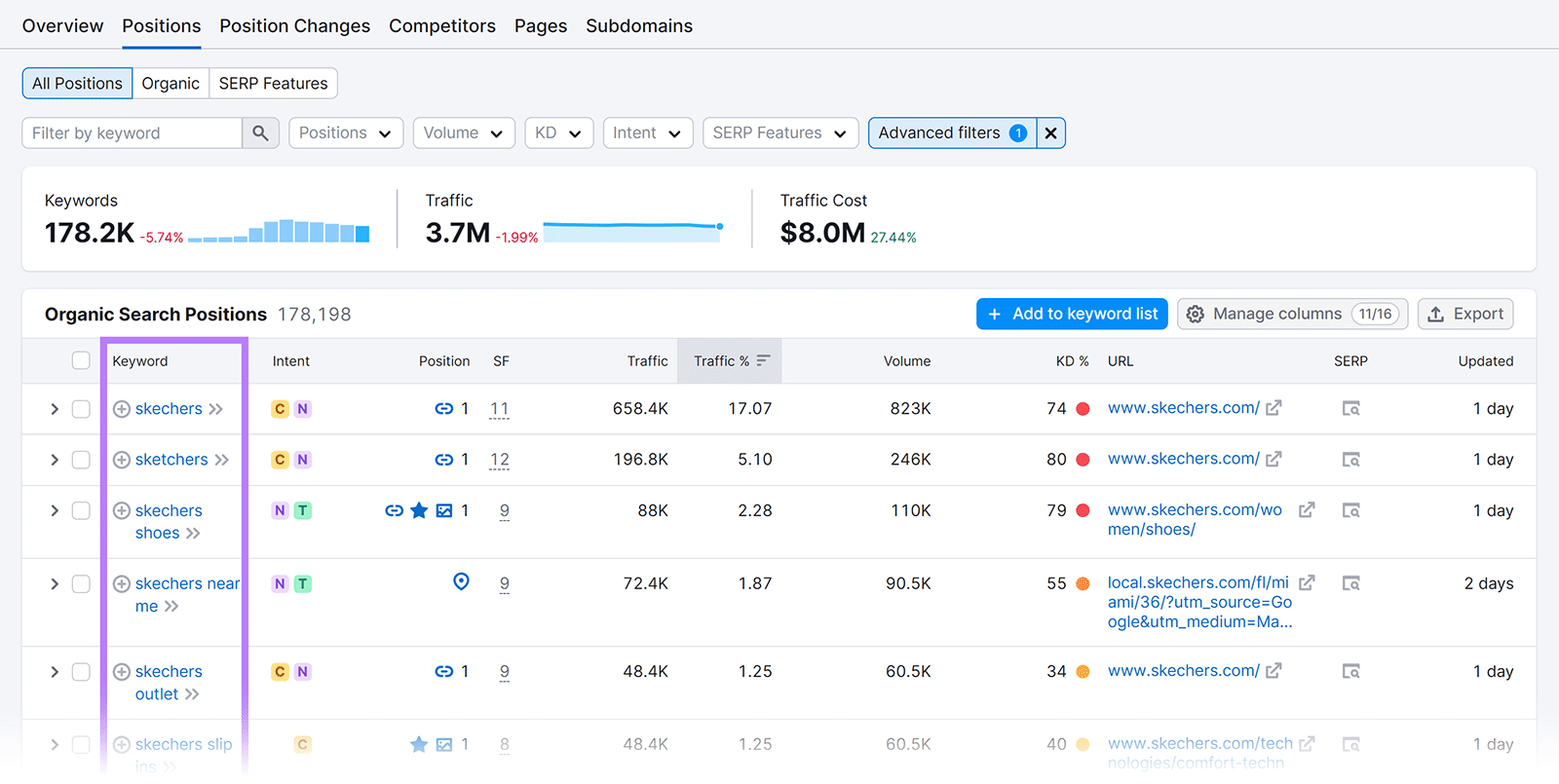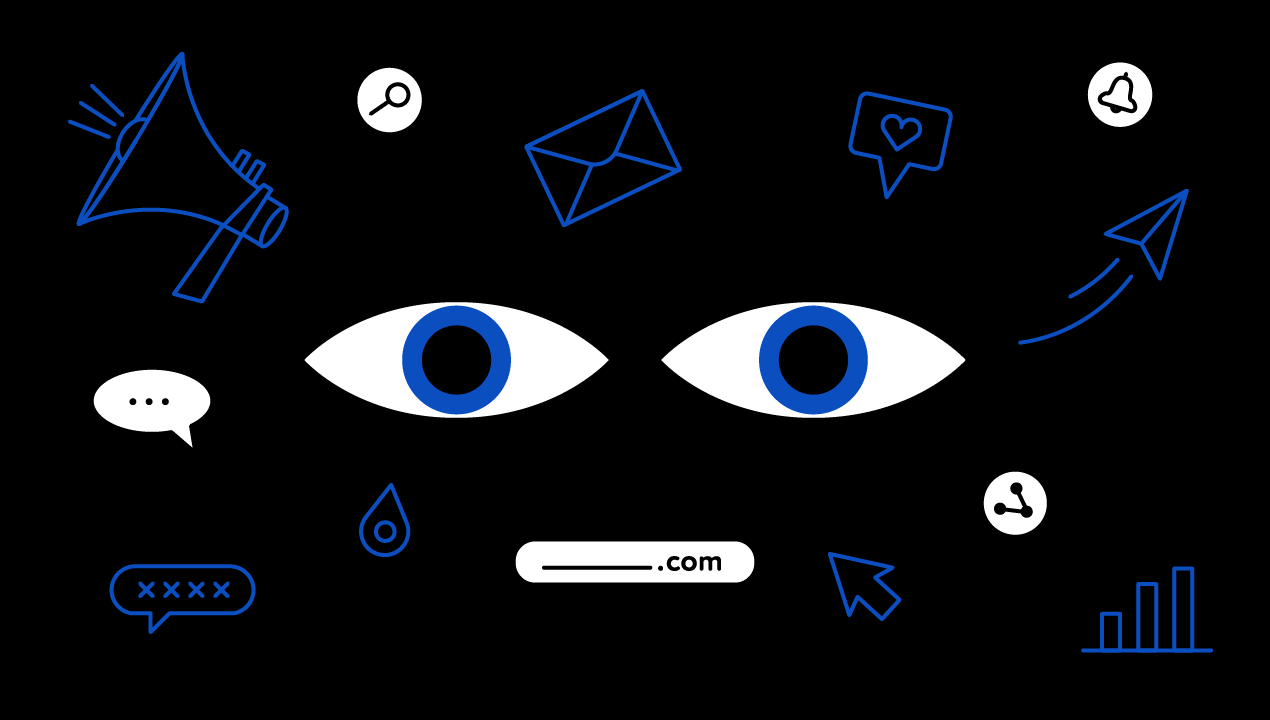In recent years, the term "brand visibility" has become associated exclusively with social media presence. All of the main brand visibility metrics revolved around being seen on Instagram, Twitter (X), Facebook, or other platform of choice. In reality, brand visibility is about being visible everywhere your target audience spends their time.
Brand visibility is the total public presence of a brand, all across online and offline media, social media platforms, search engine results pages, and any place your (potential) clients are.
That leaves us with two challenges: how to increase brand visibility and track the results of your brand visibility strategy. Let's find out.
TRACK THE VISIBILITY OF YOUR BRAND FOR 7 DAYS FREE
Start tracking your brand and keywords for free (no credit card required) in Prowly.
- Comprehensive Monitoring: Track the web, social media, print, and broadcast mentions
- Transparent Pricing: Plans start at $258/month
- All-in-one platform: Get everything you need in one tool for PR, incl. media database, outreach, reporting, and more
What is brand visibility?
Brand visibility refers to how easily and frequently (potential) customers see, recognize, and remember your brand. It encompasses a brand’s presence across multiple channels, including search engines, social media, websites, advertisements, and physical locations.
👉 The key channels to measure brand visibility include social media, search engine results pages, print, TV, radio, earned media, and similar channels.
When measuring brand visibility, it's essential to differentiate it from brand awareness.
Visibility is how many people see you, while brand awareness is how many people remember you.
Visibility is crucial for any brand because it's the starting point to building customer trust. If you have a recognizable brand, target clients and customers are more likely to risk spending money on you, especially if you have social proof from existing customers.
Ready to use a tool that will increase your brand visibility?
How to measure brand visibility
Tracking business visibility is easier than ever, despite the growing number of channels on which audiences spend their time. Here's how to manage your brand visibility and monitor the success of your marketing strategy.
#1 Media coverage metrics (traditional & digital)
A mix of traditional and digital media presence can provide your brand with a great overall health check. Here is what to track:
Media mentions
This is the simplest of coverage metrics and it shows you how many times your brand is mentioned in publications, both online and offline. Even with the smallest business, tracking this manually can become a chore.

A tool like Prowly helps you monitor your own mentions and those of your competitors. Simply put in the terms you want to track and say how you want to be notified and new mention reports will come in as requested.
Share of Voice (SOV)
This metric shows how visible your brand is compared to your competitors across media coverage. In other words, what percentage of the total mentions in your industry belong to your brand?

To calculate your SOV, you'll need the total coverage in your industry, which is very hard to pull off manually. However, you can do it automatically with Prowly and other PR tools.
Prowly helps you:
➖ Track online mentions of your brand and competitors.
➖ Use custom filters like media type, sentiment, backlinks, and languages.
➖ Track mentions in blogs, forums, print, and broadcast media.
➖ Get various reporting graphs to visualize change over time.
Try out all Prowly has to offer for 7 days free!
Social media reach/estimated audience
You can determine the size of your potential audience based on how many publications are talking about you. It's not super precise, but it's a decent benchmark to set and track.
If you're small enough, tracking this metric manually is easy and your social media dashboards can tell you the bulk of the data you need to know. However, tracking manually stops making sense as your brand grows, especially once you become present on multiple platforms.
This is where Prowly comes in:
- Social media monitoring: Prowly tracks the visibility and engagement (likes, shares, comments) of press releases and stories shared across platforms like Twitter (X), LinkedIn, and Facebook, among others.
- Engagement metrics: Prowly provides a full analysis of interactions, impressions, and click-through rates so you can understand the reach and effectiveness of social posts and publications.
- Audience insights: Prowly provides information on audience demographics, location, and behaviors to determine the quality and extent of your reach.
- Influencer tracking: Prowly helps you monitor influential figures or journalists who can amplify your content on social media, thus extending your overall reach.

Media sentiment
When you know how many people mention you, the next best thing is learning how they feel when they talk about you. Media sentiment helps you gauge public perception about your brand. In other words, you can find out at a glance the sentiment of a large number of mentions.
Once again, it's almost impossible to do this manually, but a tool such as Prowly can help.
Prowly takes in all of your media mentions and, with the help of AI, groups them as positive, negative, or neutral.
💡 We prepared three articles to help you with measuring sentiment effectively:
➖ A Guide: How to Use Sentiment Analysis in PR?
➖ A Guide: How to Measure Brand Sentiment in PR?
➖ A List: 20+ Top Sentiment Analysis Tools for PR Pros
#2 Social media visibility metrics
These metrics help you determine how many people see you on social media. If you use the right tools, you can determine how visible you are compared to your competition.
Brand mentions
Track brand mentions using Prowly's media monitoring feature. This feature captures when and where your brand is mentioned across various online and offline platforms. Regularly reviewing these mentions as part of your social listening efforts helps gauge brand reputation and the impact of your PR campaigns.

Reach & impressions
Measure reach and impressions by tracking the number of people who viewed your content (reach) and the total number of times it appeared on screens (impressions). Use tools like Google Analytics, native social analytics, or dashboards in tools like Prowly to evaluate the exposure of your brand messaging.
Engagement rate
Assess engagement rate by dividing interactions (likes, comments, shares, clicks) by total impressions or reach. From this you can get your percentage. A higher engagement rate indicates that your content is really resonating with your audience.
💡 Tip: If you want to make your PR strategy truly robust, read these articles to learn how to manage your brand reputation and protect its reputation.
Use Prowly to track reach, impressions and engagement all in one place.
#3 Website & search visibility
Organic search is one of the most profitable and scalable channels for growth for many businesses. By tracking your website's performance, you can determine how successful you are at attracting visits from Google and other search engines and gain insights into what you can do better.
Branded search volume
Measure branded search volume by tracking how many searches contain your brand or product name through tools like the Google Search Console or Semrush. Regularly monitoring these searches helps assess your brand awareness growth over time.

Referral traffic
You can track referral traffic by analyzing visitors to your website via external links even by using free tools like Google Analytics. High-quality referral traffic indicates strong partnerships and valuable backlinks.
Direct traffic
Evaluate direct traffic by examining visitors who enter your URL directly into their browser or via bookmarks, these numbers are also provided by Google Analytics. Increased direct traffic reflects stronger brand recall and customer loyalty.

SEO visibility (keyword rankings)
You can measure SEO visibility by tracking your website's keyword positions in search engines using tools like Semrush or Ahrefs. Seeing your rankings go up shows your successful SEO strategies and higher organic search presence.

P.S. Check out our guide on brand performance to learn more about strategies and measurement techniques.
#4 Audience perception metrics
Brand recall surveys
Measure brand recall using surveys that ask respondents to list brands they remember in your category without prompts (unaided recall) or to recognize your brand from a provided list (aided recall). You can compare your results over time to see shifts in brand memorability and market position.
Customer feedback (where they heard about you)
Understanding how customers discover your brand is crucial for measuring marketing effectiveness.
1️⃣ A popular method is to add a simple question like “How did you hear about us?” to your checkout forms or signup pages. This will give you quick insights into your strongest acquisition channels.
2️⃣ You can also use short email surveys sent out after a purchase or signup, asking customers to share how they found your business.
3️⃣ For deeper insights, consider customer interviews. These conversations let you probe further into their journey and uncover unexpected referral sources or patterns.
4️⃣ Social media polls and quizzes can help you quickly gather informal feedback from followers, especially if you're active on platforms like Instagram, LinkedIn, or Twitter.
5️⃣ Finally, analyzing comments or conversations on social media or review platforms usually reveals how customers discovered your brand through word-of-mouth, influencers, or other indirect channels.
How to increase brand visibility
You no longer need to wonder, "Why is brand visibility important?" or why you want to increase it. Here are some practical tips for different channels.
PR and media outreach
Don't wait for journalists to talk about you, go and meet them where they want to see you: in their inboxes. To get featured in online publications, newspapers, TV, radio and broadcast media, you need to have something worth talking about. And once you do, reach out to the right journalists to cover your story.
To do this, first you need to create a stellar press release and then send it out to a highly targeted list of journalists. The great news is, Prowly has tools for both.
With our AI-powered press release creator, you can go from a few basic ideas to a finished press release in a matter of minutes. And our PR CRM lets you find the right journalists to contact and build relationships with based on your business and keywords.
Create high-quality content
Great content can not only fuel business visibility but also bring in more leads, if it's based on a proper SEO strategy and targeted keywords. Some of the content formats you can use include:
- Blog posts
- Case studies
- Whitepapers
- Ebooks
- Thought-leadership content
If you do some research beforehand and select relevant keywords for content creation, you can gain higher visibility in search engine results.
Once you've mastered written content, you can try creating videos to foster more engagement and views on YouTube, TikTok, Instagram, and other platforms.
Take care of your social media presence
Pick your most relevant social platform (or several) and be there to engage with existing and new audiences. For example...
- Reply to comments and reviews
- Take care of all your brand mentions
- Highlight user-generated content
- Show behind-the-scenes content about your business
- Do employee advocacy programs to promote your people and their contributions
Once consumers recognize your brand based on your organic content, take the next step and find relevant influencers to partner with. This will reaffirm where your brand stands and help you stand out in front of niche audiences for an excellent return on investment.
Do event sponsorships and partnerships
When you have a chance to speak at an industry event, be there to increase visibility for your brand. Regular interaction with viewers and attendees can go a long way toward building a larger audience of potential clients and customers.
If you have the time and resources, host an event of your own. While in-person events can be incredibly expensive, hosting a webinar is not only affordable but also easy. You can also promote your events on various marketing channels where your customers are to get even more visibility for your brand.
Collect online reviews and testimonials
After successful customer interactions (such as a completed purchase or a great customer service call), encourage your satisfied clients or customers to leave a review for your business. Great places include Google, Facebook, TrustPilot, G2, Capterra, and others.

This kills two birds with one stone: potential customers can see social proof when considering your products or services and you can reuse the best reviews for your future content.
Do paid ads
While not the most popular channel for boosting brand visibility, it's great for companies in the early stages and those that want an immediate and easy-to-track return on investment.
Consider using social media ads and Google Ads to show up in front of more consumers and increase your overall footprint. If you're feeling bolder and you've done your research, paid influencer partnerships should be your next step.
Common mistakes to avoid
When growing or measuring your business visibility, it's pretty easy to make small mistakes with big consequences.
The first one is focusing on paid ads only. Out of all the marketing channels, it's the easiest for tracking down every impression and cent you spend. It's crucial, but you should also combine it with organic and earned media for the full scope of your business visibility.
The second error is inconsistent messaging across different platforms. For example, if social media users and website visitors get two different versions of your tagline and offer, you can't measure and compare your brand visibility effectively. You may as well be tracking visibility for entirely different businesses.
Third, you're making a mistake if you're not regularly tracking your visibility metrics. With modern media monitoring tools, you can put brand visibility tracking on autopilot.
Fourth, focusing all of your efforts on social media channels. Even if it's your most successful platform, you should still measure and monitor different marketing channels to see the different levels of brand exposure to get the full picture.
Last but not least, the easiest mistake to make is to only track your online presence. With so much of the world being digital, it's only natural to forget about print, TV and radio. However, there are plenty of potential customers on these channels and monitoring them is not that difficult or expensive anymore.
💡 Tip: When choosing a media monitoring service, make sure it’s tailored to local media — for example, the UK market.
Wrapping up
Measuring and improving brand visibility should be one of your primary concerns if you work in a PR or marketing team. Up until recently, doing this required dozens of different tools and tons of work. But nowadays, modern PR software gives you access to all the features you need in one dashboard.
Start monitoring your brand with Prowly for 7 days free
Start tracking your brand and keywords for free (no credit card required) in Prowly.
- Comprehensive Monitoring: Track the web, social media, print, and broadcast mentions
- Transparent Pricing: Plans start at $258/month
- All-in-one platform: Get everything you need in one tool for PR, incl. media database, outreach, reporting, and more

